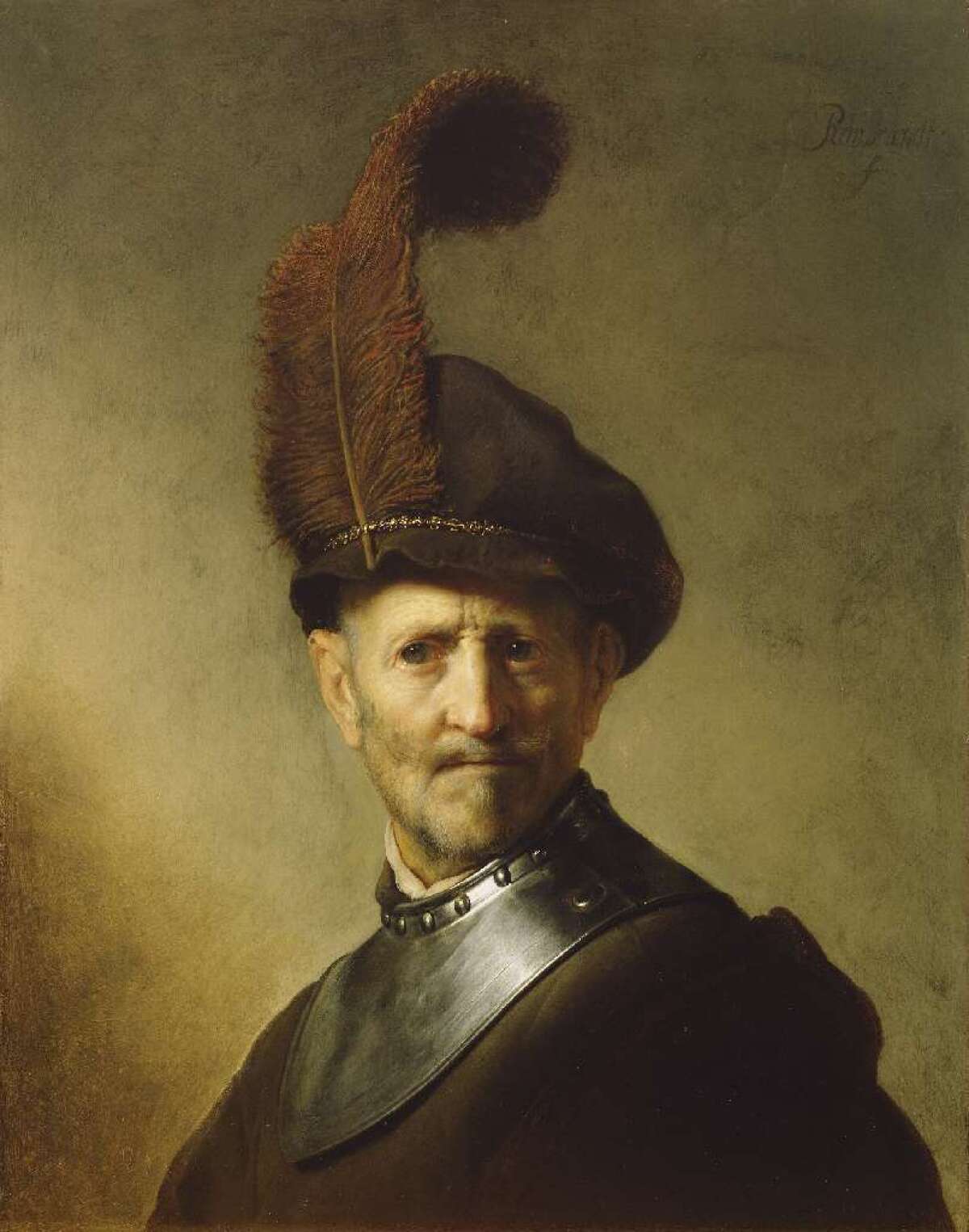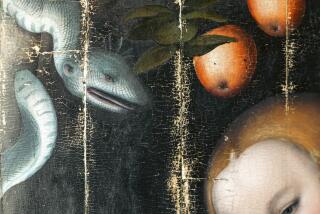Getty learns more about young man lurking beneath its Rembrandt ‘Old Man’

Rembrandt’s “An Old Man in Military Costume” hangs at the Getty Museum, which has been trying to learn more about the portrait of a much younger man that’s hidden beneath it. A new study using advanced X-ray technology gives a clearer picture of the hidden picture.
- Share via
Youth inevitably gives way to age, but the blow was particularly sudden and stark for a young man whose portrait Rembrandt painted almost 400 years ago.
For reasons unknown, the great artist obliterated the young fellow from the two-foot-tall wooden panel on which he’d been painted. Applying fresh oil paints, Rembrandt covered him with a new and very different portrait –- an old man in a feathered cap and a metal collar who seems to be putting on a brave face but has a worried look in his eyes.
“An Old Man in Military Costume” has been a highlight of the Getty Museum’s collection since its purchase in 1978. But now 21st century technology is bringing a bit more recognition to the buried youth who disappeared around 1630, when Rembrandt, then in his mid-20s, painted the old fellow over him.
Bit by bit researchers are uncovering more of the expunged figure – not by cutting through the cherished portrait on top of him, but by meticulously bombarding it with advanced x-ray technology.
“Rembrandt’s `Old Man in Military Costume’: the Underlying Image Re-examined,” an article to be published Tuesday in the journal Applied Physics, brings a bit more of the eradicated youthful figure into view. Authored by three scholars from the Getty and three x-ray technology experts from Belgium and Holland, the study includes what the Getty is calling a “tentative color reconstruction” of the long-submerged portrait.
According to the new findings, the young man about whom Rembrandt apparently changed his mind had a healthy-pink complexion and wore a green cloak with a thick collar that was probably a grayish shade.
His presence was discovered in 1968 in a long-term study, the Rembrandt Project, that included systematically x-raying his paintings. The follow-up scan conducted last year was the Getty’s second attempt to fill in the hidden picture since acquiring “Old Man.”
“Every 20 or 30 years technology advances to the point where we have new tools to look at it in a new way and get new information,” said Karen Trentelman, senior scientist with the Getty Conservation Institute.
The latest technique used on the painting, Macro X-ray Fluorescence (MA-XRF for short) is not brand new, but the device employed in the study is a new portable model built specifically for scanning paintings.
It was developed and deployed by Koen Janssens and Geert van der Snickt of the University of Antwerp in Belgium and Joris Dik of Delft University of Technology in the Netherlands, who are credited as co-authors of the study along with Trentelman and two others from the Getty, paintings conservator Yvonne Szafran and paintings curator Anne Woollett.
------------
For the Record
Sept. 1, 5:28 p.m.: An earlier version of this article misspelled Getty paintings conservator Yvonne Szafran’s last name as Szafaran.
------------
Sending a Rembrandt out for an x-ray exam is no small matter. Rather than take it to a lab at Stanford that has a MA-XRF machine, Trentelman said, the Getty waited for the European experts to perfect their portable scanner, which looks like a large, old-fashioned drafting table. The Bruker M6 Jetstream, as it’s called, arrived packed in three crates and was about the size of a desk when assembled.
Working in April, 2013, in a conservation lab beneath the Getty’s gift shop, Trentelman and her team of scientists, conservators and curators put “An Old Man in Military Costume” on an easel and subjected it to a single scan that lasted 30 hours. Team members took baby-sitting shifts, it being highly inadvisable to leave a Rembrandt unattended, especially in a place prone to earthquakes.
While they had the device on loan, Getty conservators also used it on Jackson Pollock’s huge painting, “Mural,” which the University of Iowa Art Museum had sent for cleaning.
In 1996 the Getty had probed for the ghost inside its Rembrandt with a less precise, earlier generation technique called neutron activation autoradiography. Trentelman said it had identified clusters of elements found in the paint, but lacked the pinpoint accuracy needed to create a detailed image.
--------------------------------
For the Record, Sept. 2, 10:45 a.m.
For the Record: An earlier version of this article misspelled “neutron activation autoradiography” as neuron activation autoradiography.
---------------------------------
The MA-XRF scan was able to show exactly where certain elements turned up on the wooden panel, and at what depth. Matching the results with the chemical makeup of pigments Rembrandt is known to have used, the researchers could theorize as to the colors and shapes in his portrait of the youth.
Mercury, associated with vermilion, was strongly present in the facial area along with lead that could blend the red to pink; lots of copper in the cloak suggested a greenish hue. Trentelman said that the scan also turned up a field of iron particles arrayed in the shape of a collar, a previously hidden detail that allowed the team to fill in the picture a bit more.
The pigments suggested by the scan give an outline of the young man’s face, but it “stops kind of abruptly with a sharp line,” Trentelman said, suggesting he wears some sort of head covering or hat. “But with current technology we can’t see what that is.”
MA-XRF scans are good for detecting heavier elements, Trentelman said, and Rembrandt apparently used oils made of lighter substances to paint the head covering.
The Getty borrowed the scanner for its study, but the art conservation scientist said she has one on her wish list. “It would be wonderful to have. We’ve been talking about it but it’s not cheap,” retailing at more than $300,000.
Paintings curator Woollett said there will be a follow-up article focusing on the relationship between the surface and hidden images on the wood panel, and on what the two paintings say about Rembrandt’s creative process early in his career.
While’s it’s possible that the portrait of the young man was painted by somebody else, then acquired by Rembrandt and painted over, Woollett said, Rembrandt’s known habit of painting over works he’d already made, and the style of the hidden painting, point to him as creator of both portraits.
The Getty doesn’t plan to make a replica of the hidden painting to show in the museum alongside the portrait that usurped it, Woollett said.
A replica of sorts does exist, conservation scientist Trentelman said, painted a few years ago by a Getty intern who used “our best guess” about the colors the subsequent MA-XRF scan might reveal. The mock-up was scanned at Stanford in a practice run for the real test subsequently done at the Getty.
“It’s pretty good,” Trentelman said, “but it’s no Rembrandt.”
Follow https://twitter.com/boehmm of the LA Times for arts news and features
MORE:
Broad museum’s online reservation system crashes; first two days sold out
Segerstrom Center launches $68-million drive to redesign plaza and cover fundraising failure
When is a Michelangelo not a Michelangelo? Perhaps in ‘Vatican Splendors’
More to Read
The biggest entertainment stories
Get our big stories about Hollywood, film, television, music, arts, culture and more right in your inbox as soon as they publish.
You may occasionally receive promotional content from the Los Angeles Times.











